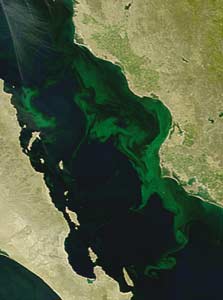May, 2004
 In the next 25 years, a very large share of the additional wheat needed to feed the rising population in developing countries will come from intensive farming systems. It is more important than ever to learn how to reduce the impact of intensive agriculture on the environment while ensuring that those systems can supply much-needed food in the years to come.
In the next 25 years, a very large share of the additional wheat needed to feed the rising population in developing countries will come from intensive farming systems. It is more important than ever to learn how to reduce the impact of intensive agriculture on the environment while ensuring that those systems can supply much-needed food in the years to come.
One such system is the Yaqui Valley in northwestern Mexico, site of CIMMYT’s main wheat research station. “Because of its location—between the ocean and a mountain range—the Valley serves as an ideal laboratory for investigating the long-term effects of intensive farming on neighboring ecosystems,” comments David Lobell, a Stanford University researcher collaborating with CIMMYT. “These effects have regional implications—for example, for the Sea of Cortes and adjacent ecosystems—as well as global consequences, since they contribute to global warming and, ultimately, climate change.”
Remote sensing by NASA satellites, started in 1999 as part of the CIMMYT/Stanford University collaborative study, is a new way of studying farming activities in the Valley. Forty percent of the wheat produced in the developing world comes from irrigated environments resembling the environment in the Valley. Because of this similarity, investigations conducted in the Valley have applications far beyond it, particularly in the intensive production systems of South Asia, which feed billions of people.
The Latest Applications of Remote Sensing in the Valley
The Yaqui Valley can be thought of as a large experimental field, made up of individual farmers’ fields. These farmers can be divided into three groups. Some plant wheat too early, others plant it on time, and others plant it too late. During each cropping cycle, researchers use remote sensing to make thousands of observations across the whole Valley and determine how different sowing dates affect wheat yields. This procedure is more effective than establishing a trial specifically to test the effects of different planting dates at a research station.
Based on the resulting information, CIMMYT researchers have calculated that in bad years, when temperatures are high and water is scarce, late planting causes yield losses worth about US$ 10 million in the Valley. “This information comes just in time for wheat farmers, who can adjust their sowing dates and cope better with the intense drought we’ve had in the Valley for the past eight years,” says Ortiz-Monasterio.
In good years, when there is enough water and cool temperatures, the effect of late sowing on wheat yields is either negligible or nil. Nonetheless, data on when most farmers sow their wheat are potentially useful to decision makers, who, based on these data, could ensure that credit and irrigation water are available to producers when they are ready to plant.
Remote sensing is also being used for tracking nitrogen derivatives that are released into the atmosphere or leached into the soil with irrigation water. Currently several Stanford professors are leading teams that study the effect of irrigation water that flows from the Yaqui Valley into the Sea of Cortes, about 20 km away. They are observing the increases in the algae bloom and/or the plankton in the Sea, and so far the increases seem to coincide with the outflow of irrigation water from the Valley. If this finding is confirmed, recommendations need to be made to Valley farmers that would allow them to reduce their nitrogen fertilizer applications.
In years past, CIMMYT wheat agronomists have worked out strategies that could dramatically reduce the amount of fertilizer applied to wheat without affecting yields. For example, farmers could reduce nitrogen applications by more than 30% if they apply less fertilizer exactly at the time when the crop starts pulling nitrogen from the soil. Currently farmers apply nitrogen with irrigation water, weeks before wheat is actually sown. This practice causes nearly 35% of the nitrogen to be lost through gas emissions and leaching before the crop is even in the ground.
Sensing Plants’ Nutrient Needs
Another way of fine-tuning fertilizer applications is to use an electronic sensor that is held over the wheat crop by a technician walking through the field. The sensor detects which plants need fertilizer and allows farmers to apply the exact amount of nitrogen at the right time, thereby reducing waste and farmers’ production costs. But, most importantly, this practice would reduce the amount of unused nitrogen that leaches through the soil and into the Sea of Cortes with the outflow of irrigation water. “Because individual farmers cannot afford to have their own sensors, we envision that district representatives in the Valley could offer this detection service to farmers districts every crop cycle,” comments Ortiz-Monasterio.
For more information, contact Ivan Ortiz-Monasterio.
 Capacity development
Capacity development